How to care for irises after flowering: removing flower stalks, pruning in autumn, preparing for winter
Growing irises is not as difficult as it might seem to beginner growers. Moreover, it will not be difficult to properly prepare irises for winter, of course, if you know all the nuances of caring for a plant after flowering. Actually, this is why you are reading these lines, trying to find an answer to one of the following questions about growing irises:
- Do I need to cut the peduncles after flowering, why and how to do it?
- Should the leaves be trimmed after flowering?
- When and how to prune irises in autumn?
- Do they need shelter and what kind?
Answers to all these questions regarding how to properly care for irises after flowering, as well as in the fall while preparing the bushes for winter, will be given below.
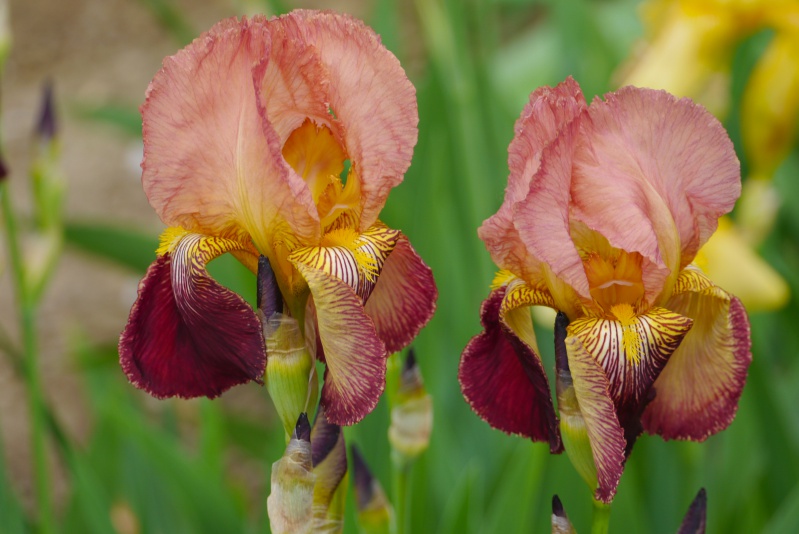
Content
- 1 Iris care after flowering and in autumn - preparing flowers for winter
- 2 Pruning irises after flowering and in autumn
- 3 Autumn feeding of irises
- 4 Planting, dividing and transplanting irises in the fall
- 5 Shelter of irises for the winter
- 6 Features of autumn care and preparation for winter of bulbous irises
Iris care after flowering and in autumn - preparing flowers for winter
After flowering in summer, as well as in autumn, it is necessary to carry out the following measures to care for irises and prepare them for winter:
- summer and autumn pruning (breaking out peduncles and pruning foliage);
- division and transplanting (if necessary), as well as planting (for example, planting bulbous irises);
By the way! The site already has materials about how to plant and transplant rhizome irises, as well as about the nuances planting and growing bulbous irises.
- shelter for the winter.
Note! The rest of the article will tell you what to do with rhizome irises (bearded and beardless) after flowering in summer and autumn, during preparation for wintering.
And also about bulbous irises (Xyphyum, Iridodictiums and Juno)... Caring for them is somewhat different, therefore in a separate paragraph at the end.
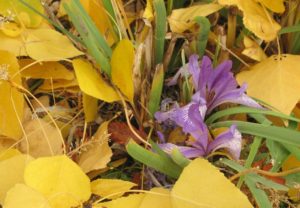
Pruning irises after flowering and in autumn
When the irises begin to fade, many growers ask themselves a completely logical question: "Is it necessary and how to properly cut the irises after flowering?"
The short answer is yes, irises need pruning after flowering.
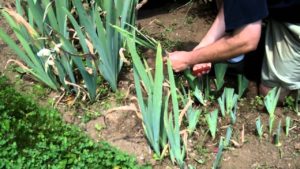
Pruning peduncles after flowering
Firstly, it is necessary to remove, or rather break off, all peduncles at the optimal time (i.e., timely).
Another popular question: “How long after flowering need to break out flower stalks of irises? "
Answer: As soon as all flowers will wither... If you have chosen a suitable period and the peduncle is fully ripe, then it will come off quite easily (it will break off with a bang). And if it bends and does not break, then it is too early (the peduncle has not matured).
If you do not do this on time, then seed pods are formed, in other words, the plant will spend a lot of extra energy on reproduction.
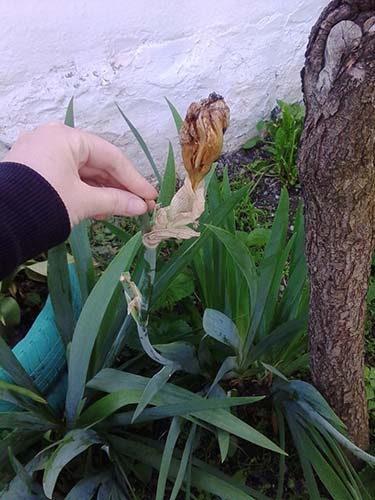
- The most favorable moment (weather) for breaking the peduncles is windy, dry and sunny fine day... In such conditions all wounds will dry out very quickly, become chapped and covered with a protective crust, which means that they will not be afraid of any rot.
The biggest danger is that the junction (attachment) of the peduncle and the iris tuber is very susceptible to decay... In other words, if you do not carry out the operation to timely remove (break out) the peduncles, then the plant may rot.
- Peduncles it is better not to cut with pruners, but exactly break out by hand.
Why is it better with your hands and not with garden tools?
The fact is that, using the tools, you can easily transfer pathogens and various infections from infected to healthy plants.
Although it happens that many growers cut off safely and everything is in order.
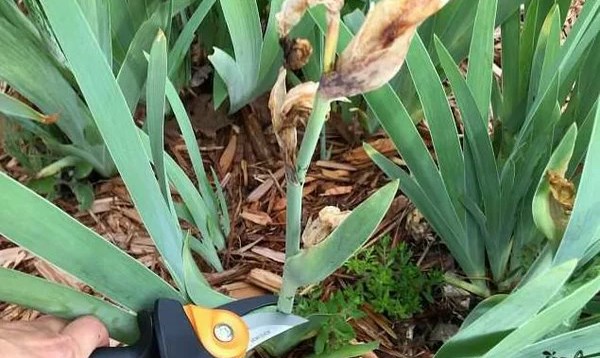
- Manual punching technology next: with your hand you grasp the lower part of the peduncle, while the thumb should be at the very root collar (the junction of the peduncle and the tuber), and then break it out with a sharp movement down towards you.
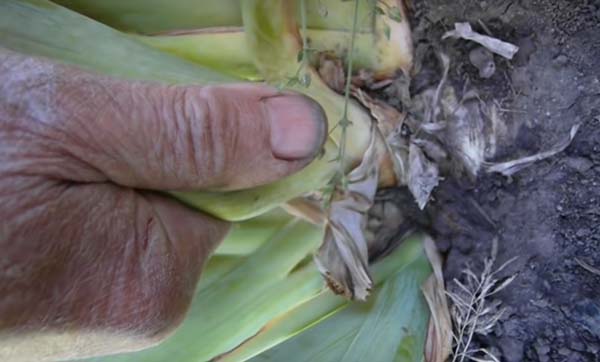
- If, after breaking a peduncle near a kind of "boat" was formed, in other words, around the left hemp leaves remained, so that moisture does not accumulate there and rotting processes do not suddenly begin, they (leaves around the peduncle) should also will removeb.
- After removing the peduncles, the irises will better ventilated and illuminated, and growth delenki actively grow and strengthen.
Video: pruning irises after flowering
Should the leaves be trimmed immediately after flowering
Nice green iris foliage at the end of flowering should not be cut in any way.
The fact is that plant root system should still recover after active flowering and stock up on nutrients before the onset of frost (and food-photosynthesis goes through the leaves), respectively, without it, too growth divisions will not be able to build up.
In any case, the foliage will remain decorative for a long time.
Another thing that follows get rid of dry leavesas well as from leaves, infected with fungal diseases (for example, from leaves with spots). And then be sure to spend spraying with one of the fungicides (a medicine for diseases) so that the disease does not go further.
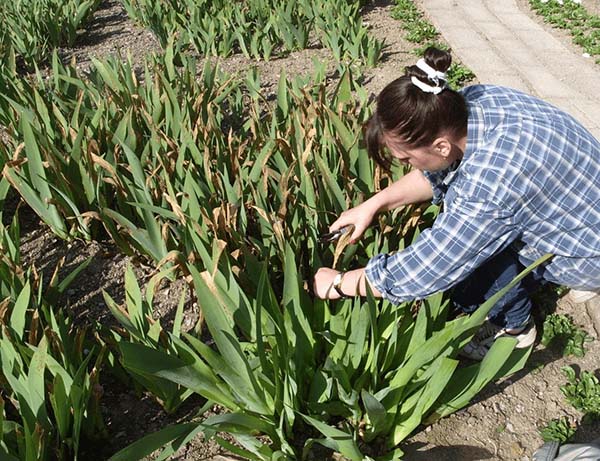
Pruning foliage in the fall before wintering
Iris foliage is cut off closer to the second half of autumn, i.e. after it becomes withered. Then it is cut at a height of 10-15 cm, giving the leaves a conical shape so that water does not linger on them.
Only good foliage is cut with a fan or a cone; everything dry must be removed completely.
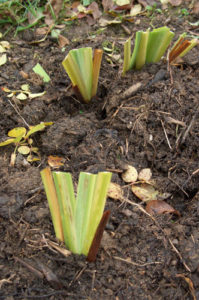
Advice! It is better to burn all the cut foliage in order to destroy the eggs of pests and pathogens that are potentially present in it (the same fungal spores).
Although, if there are no diseases, then you can send it to the compost heap.
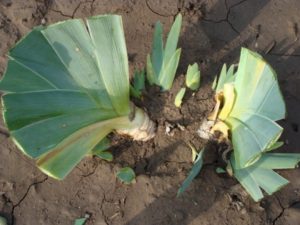
Autumn feeding of irises
If you think that the potential of irises cannot be revealed due to the fact that your soil is too poor, then 2-3 weeks after flowering or already in the fall, you should feed them phosphoric-potassium fertilizer (for example, superphosphate + potassium sulfate or just monophosphate).
By the way! If you are a supporter of organic farming, although this usually does not apply to fertilizing flowers and other ornamental plants, then you can take wood ash, bone meal, compost, humus. Only do not use fresh manure (only rotted).
Planting, dividing and transplanting irises in the fall
The need for periodic transplantation (dividing the bushes) of irises is due to the fact that over time the plant grows to the sides, which makes the middle of the bush bare, and the flowers and shoots begin to shrink.
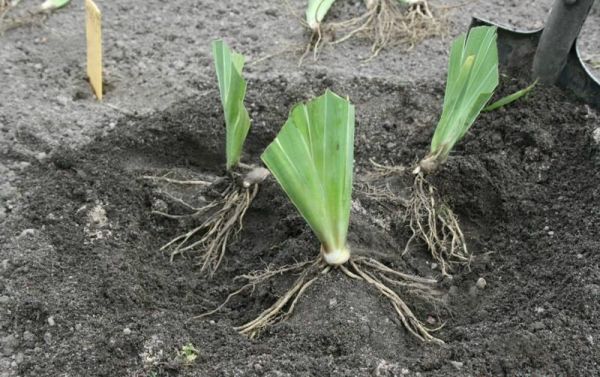
In other words, in one place, iris bushes can grow up to 3-5 years, then they are divided and planted (transplanted) in new places.
As a rule, the division and transplantation of irises begins to be dealt with just after their flowering and fragments of peduncles, somewhere in 2-3 weeks later.
Advice! The site already has articles about how to plant and transplant rhizome irises, as well as about the nuances planting and growing bulbous irises.
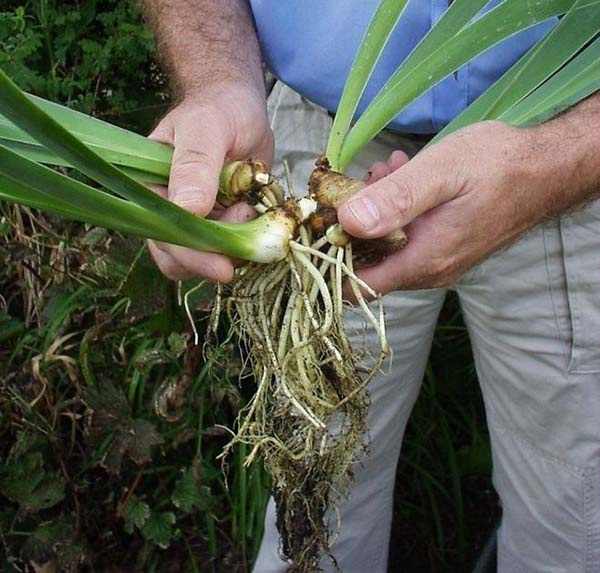
Shelter of irises for the winter
Irises hibernate very well just under the snow, in almost any conditions, and never need shelter for the winter.
Opinion: “Northern Urals, winters down to -45 degrees. I never cover irises! The secret is that when planting, the top layer of soil is sprinkled with sand 5 cm, but the backs of the irises are still on the surface. Everything will overwinter under the snow. "
However, if you have very severe frosts, then you can cover it slightly (by 2-3 cm) with dry peat, humus, needles, foliage or agrotextile (spunbond), but in no case with a film, otherwise it will be wiped out. Moreover, this must be done already in October-November, when stable frosts begin.
It is worth understanding! In some sources, you can find recommendations that irises should be mulched for the winter with a layer as much as 8-10 cm, however, this does not make any sense: they are even more likely to rot under your mulch than completely naked potatoes will freeze.
If it is worth covering irises for the winter, then only in order to protect them from excess and stagnant moisture in the early spring period, when the snow begins to melt. In other words, irises are afraid of waterlogging and dampness, because of which they can simply rot.
So that the iris bulbs do not get wet and rot from excessive moisture, they should be something cover, eg, roofing material or slate, having previously made a frame of boards or bricks.
Video: how and what to cover irises for the winter
Features of autumn care and preparation for winter of bulbous irises
Bulbous irises are much less common than rhizome irises (bearded and beardless). And if you have them planted, then caring for them is somewhat different.
So, some time after flowering (i.e. around June) you will need dig up the iris bulbs and store them until the next autumn planting:
Moreover, it is very important to do this on time, otherwise, due to excessive humidity (rains), they can rot. If tulips, as a rule, they are dug out after their leaves turn yellow, then in the case of bulbous irises, you do not need to wait so long.
- It is optimal to get them (bulbs) out of the ground for about 2 weeks after floweringwhen they just wilt slightly and begin to turn yellow. As a rule, this moment falls on the end of May - beginning of June.
Note! Irises do not need to be dug up for the summer if during this period you (in your climatic zone) have no rain at all, because they require a dry dormant period.
- Next, the dug iris bulbs follow disinfect in a pink solution of potassium permanganate or any other fungicide (for example, "Maxim Dachnik" or "Fundazol"),
- Then as follows dry (2-3 weeks) and pput in storage in a dry room with good ventilation until new autumn planting in open ground.
Important! As mentioned earlier, each genus of bulbous irises has its own characteristics of cultivation. So, xyphyums should be dried at a higher temperature (+ 30-35 degrees), and Iridodictiums and Juno - medium enough (+ 20-25 degrees). In the last days of drying, the temperature should be lowered to + 15-18 degrees.
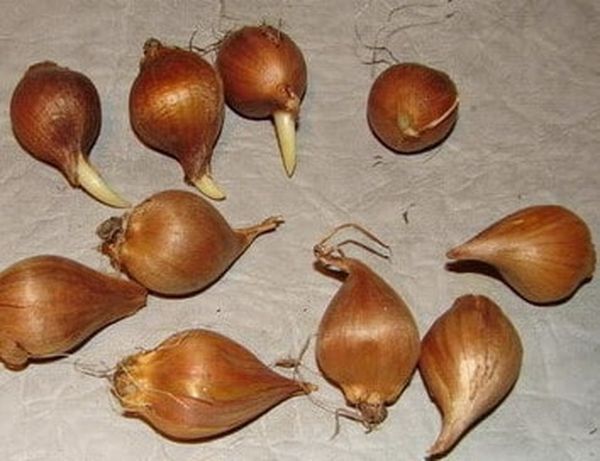
If autumn is rainy, so that the iris bulbs do not get wet from excessive moisture, they should be cover, eg, roofing material, slate or a plastic cake box.
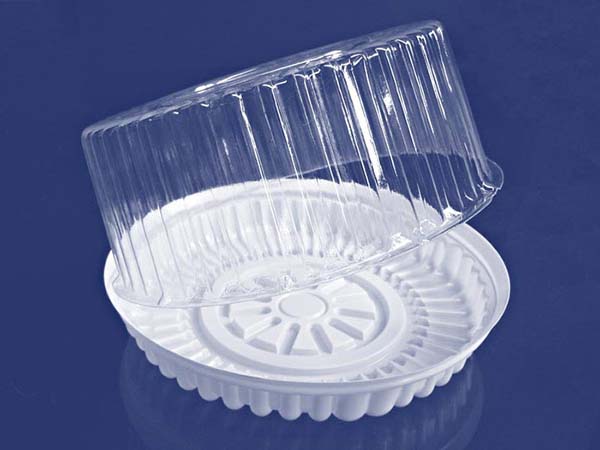
If your winters are cold and snowless, then for a winter shelter is suitable spruce branches and dry leaves, you can also hide spunbond... Special in hiding for the winter need more heat-loving juno.
Important! Do not forget to remove the shelter in early spring (immediately after the snow melts).
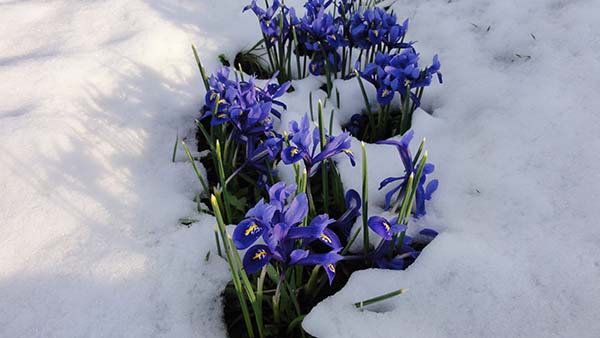
Well, now you know how to properly care for irises after flowering, as well as what to do in the fall in preparation for winter.
Think!However, many people disagree that irises generally need some kind of care, but in any case, you need to check (experiment) on your own bushes.
Gardeners' opinions:
“This weed will survive even a nuclear winter. No care, even no watering. "
“We do nothing but prune a dried bush in the fall. They grow like grass, still try to remove it. "
“Least of all I bother with irises. I only break out the peduncles. And they grow without any fertilization at all. By the way, irises are one of the most unpretentious plants. "
“I do nothing: I don’t cut, I don’t clean, I don’t feed. And they thicken, grow and bloom with forest every year! "
Video: how to prepare irises for wintering (for example, bearded ones)


Thanks, very interesting. If possible, I would like to receive newsletters from you. I would appreciate that